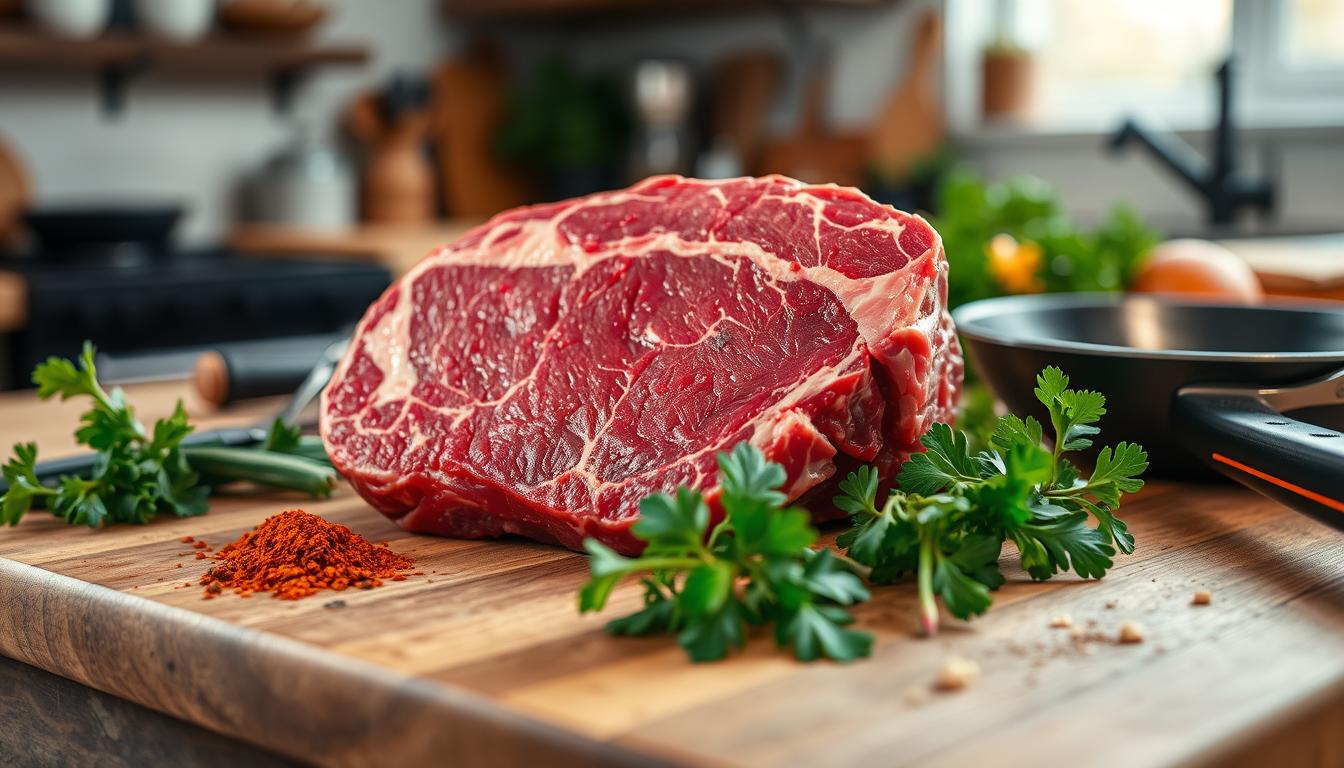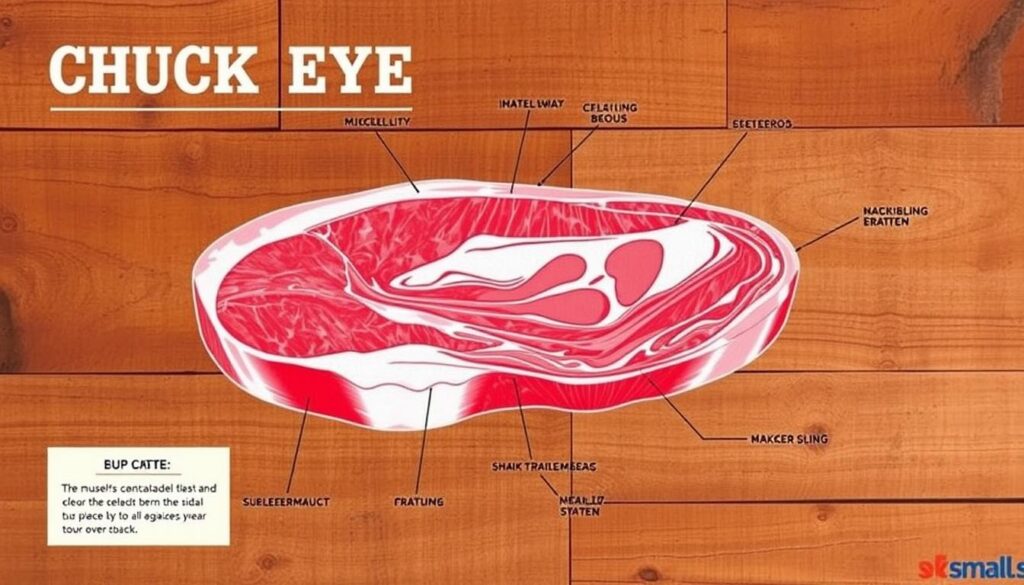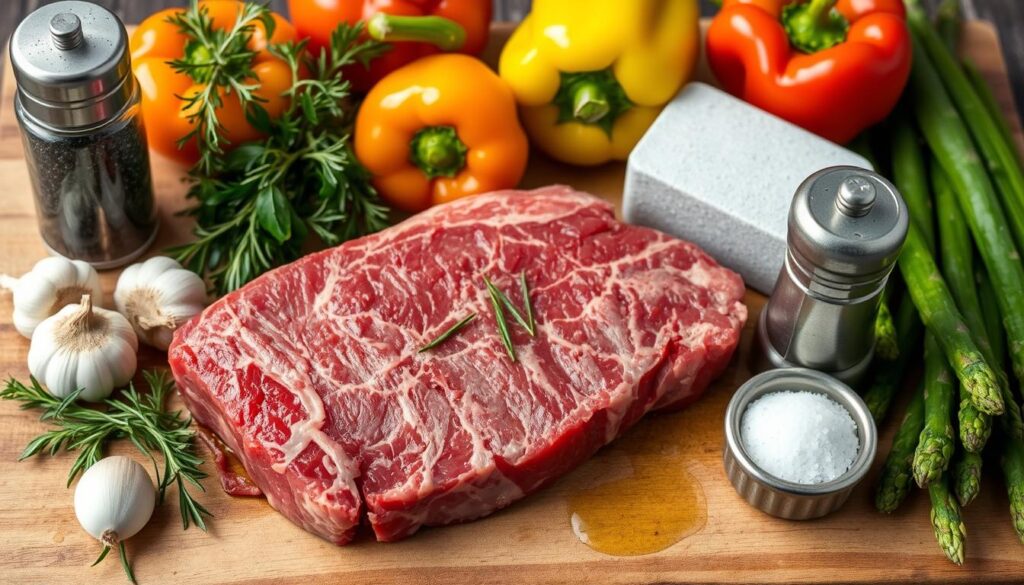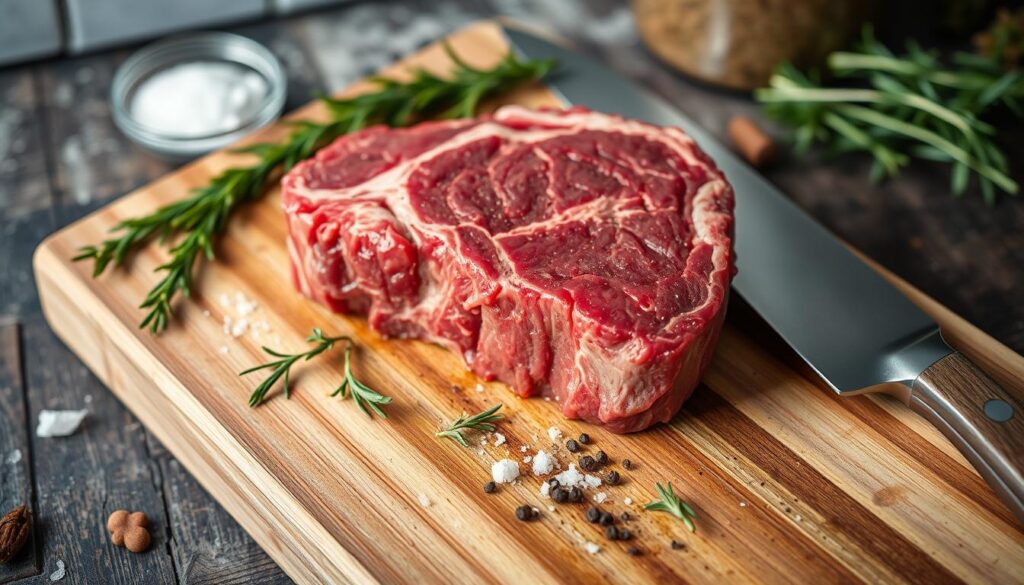The beef chuck eye steak is a hidden gem. It’s known as the “poor man’s ribeye” because it tastes great but costs less. Chefs and home cooks are finding that chuck steak recipes can make an affordable cut into a delicious meal.
In this guide, we’ll show you how to make the perfect beef chuck eye steak. You’ll learn expert techniques to make this affordable cut taste amazing. You’ll get a restaurant-quality meal right in your kitchen.
Key Takeaways
- Discover the incredible value of beef chuck eye steak
- Learn professional cooking techniques for maximum flavor
- Understand why chuck eye is called the “poor man’s ribeye”
- Master cost-effective meat selection strategies
- Uncover simple methods to enhance steak tenderness
Understanding Beef Chuck Eye Steak
Chuck eye steak is a hidden gem in the world of beef. It comes from the cow’s shoulder, near the ribeye. Meat lovers call it the “poor man’s ribeye” because it tastes similar to more expensive cuts.
What Makes Chuck Eye Special
Chuck eye steak is special for several reasons. It’s tender and flavorful, perfect for those watching their budget. Here’s why it’s so exceptional:
- Located between the shoulder blade and ribeye
- Contains higher marbling compared to standard chuck steak
- Typically yields only two steaks per cow
- Offers a rich, intense beef flavor
The “Poor Man’s Ribeye” Explained
Understanding chuck steak’s unique position is key. It tastes and feels like ribeye but costs less. This makes it a smart choice for home cooks.
Meat Quality and Marbling
Chuck eye steak’s quality comes from its marbling. It has more fat than other cuts, making it juicy and flavorful. Chefs love it because it stays tender when cooked right, making it great for many cooking methods.
“Chuck eye steak is proof that delicious doesn’t always mean expensive.” – Professional Chef
Chuck eye steak is perfect for those who want great flavor without spending a lot. It’s tender, tasty, and affordable.
Essential Ingredients for Perfect Chuck Eye Steak
Creating the best chuck steak recipes starts with picking the right ingredients. Knowing the key parts is crucial to turn a regular chuck eye steak into a dish to remember.
For top-notch chuck steak recipes, you need a mix of ingredients to make your dish stand out:
- Chuck Eye Steak: Choose USDA Choice or Prime cuts
- High-quality olive oil
- Coarse kosher salt
- Freshly ground black pepper
- Optional fresh herbs (rosemary, thyme)
“The secret to an exceptional steak lies in the quality of your ingredients.”
It’s important to know what makes chuck eye steak special. These cuts are known as the “poor man’s ribeye” because of their rich flavor and marbling. Only two chuck eye steaks can be taken from each cow, making them a rare find in cooking.
| Ingredient | Purpose | Recommended Quantity |
|---|---|---|
| Chuck Eye Steak | Primary protein | 8-10 oz per serving |
| Olive Oil | Searing and flavor enhancement | 1/4 cup |
| Kosher Salt | Seasoning and crust formation | To taste |
| Black Pepper | Flavor depth | Freshly ground |
Pro tip for chuck steak recipes: Marinating for at least six hours can make your steak tender and flavorful. Over 60% of home cooks use marinades to improve their steak’s texture and taste.
Preparing Your Steak Before Cooking
Learning how to prepare chuck steak starts with the pre-cooking steps. These steps are key to making your steak taste like it came from a fancy restaurant. With the right prep, even the most basic cut can become a mouthwatering dish.
Room Temperature Resting
Getting your chuck steak to room temperature is a must. Let it sit out for 45-60 minutes before cooking. This step helps:
- Ensure even cooking
- Keep the internal temperature consistent
- Make the meat tender and juicy
Proper Seasoning Techniques
Seasoning chuck steak is an art. Mix kosher salt and freshly ground black pepper to boost the meat’s taste. Pro tip: Season both sides generously about 30 minutes before cooking.
| Seasoning Component | Quantity | Purpose |
|---|---|---|
| Kosher Salt | 1 tsp per pound | Enhances meat flavor |
| Black Pepper | 1/2 tsp per pound | Adds subtle heat |
| Garlic Powder | 1/4 tsp | Provides depth of flavor |
Surface Preparation Tips
Before cooking, pat your chuck steak dry with paper towels. This step is crucial. It removes excess moisture, helping your steak sear better. A dry surface is essential for a delicious crust.
“Preparation is the secret to transforming an ordinary chuck steak into an extraordinary meal.” – Professional Chef
The Perfect Seasoning Blend
Creating the ultimate seasoning blend can make your chuck steak recipes stand out. The right mix of spices brings out the meat’s natural flavors, making each bite unforgettable.
When seasoning chuck eye steak, start with basics. Coarse sea salt and freshly ground black pepper are key. They let the meat’s rich taste shine.
Essential Seasoning Components
- Kosher salt for robust flavor
- Freshly cracked black pepper
- Garlic powder
- Smoked paprika
- Dried herbs like thyme or rosemary
For a deeper flavor, try Montreal Steak Seasoning. It has six main ingredients. It’s low in calories but packs a lot of taste.
“The right seasoning can turn a good steak into an unforgettable meal.” – Professional Chef
Pro tip: Keep your homemade seasoning in an airtight container for up to 6 months. After that, the spices lose their flavor.
Quick Seasoning Mix Recipe
- Combine 2 tablespoons kosher salt
- Add 1 tablespoon black pepper
- Mix in 1 teaspoon garlic powder
- Sprinkle 1/2 teaspoon smoked paprika
- Blend thoroughly and store
Your seasoned chuck steak will taste amazing and be good for you. It’s low in calories but full of flavor. This seasoning makes your chuck steak recipes the highlight of any meal.
Creating the Ultimate Herb Butter
Take your chuck steak recipes to the next level with a delicious herb butter. This special butter turns a simple meal into a gourmet delight. It adds richness and depth to your chuck eye steak, making it a hit with food lovers.
Butter Base Components
Begin with high-quality unsalted butter that’s at room temperature. Softened butter is key for a smooth, creamy herb butter. It blends well with fresh herbs and seasonings.
- Unsalted butter (1/2 cup)
- Minced fresh garlic (2-3 cloves)
- Sea salt (1/4 teaspoon)
- Freshly ground black pepper
Fresh Herb Selection
Choosing the right herbs is crucial for chuck steak recipes. Fresh herbs add vibrant flavors that match the meat’s richness perfectly.
- Chopped fresh thyme
- Finely minced rosemary
- Fresh parsley
Mixing and Storage
Mix softened butter with chopped herbs and seasonings. Make sure to mix well until everything is evenly spread. For the best taste, chill the herb butter for at least 30 minutes before serving.
“A great herb butter can transform a simple steak into a restaurant-quality dish.”
| Ingredient | Quantity | Purpose |
|---|---|---|
| Unsalted Butter | 1/2 cup | Creamy base |
| Fresh Thyme | 1 tablespoon | Aromatic herb |
| Rosemary | 1 teaspoon | Intense flavor |
| Garlic | 2-3 cloves | Flavor enhancement |
Pro tip: Wrap your herb butter in plastic wrap and store it in the fridge. It stays fresh for up to a week, ready to add flavor to your next chuck steak recipe.
Cooking Methods and Equipment
Choosing the right cooking method is key to a great chuck steak experience. Chuck eye steak is versatile, making it perfect for many cooking styles. This turns an affordable cut into a top-notch meal.
- Cast Iron Skillet Searing: Provides the most consistent and flavorful results
- Outdoor Grilling: Adds smoky char and enhanced flavor profiles
- Oven Finishing: Ensures even cooking and temperature control
For the best chuck steak, a cast iron skillet is the top pick. Professional chefs say it’s the best for a perfect golden-brown crust.
“The right equipment can transform an average steak into a culinary masterpiece.” – Chef Michael Rodriguez
When picking your cooking tools, consider these must-haves:
- Heavy-bottomed cast iron skillet
- Meat thermometer
- Tongs for safe meat handling
- Aluminum foil for resting
Cooking times depend on your desired doneness. For a 1-inch thick steak, sear for 3-4 minutes on each side. Letting the meat rest for a few minutes makes it tender and juicy.
Step-by-Step Cooking Process
Cooking a perfect chuck steak needs care and precision. Knowing the right techniques can turn this affordable cut into a tender, tasty meal. Here are the key steps to make a delicious chuck steak that will wow your guests.
Preheating Your Cooking Surface
Getting ready is key for a tender chuck steak. Choose a heavy-bottomed cast-iron skillet or grill pan. Heat it over medium-high until it’s about 400-450°F. This high heat is essential for a great sear.
Searing Techniques for Maximum Flavor
Searing is a vital step in making chuck steak recipes. Here are some expert tips:
- Pat the steak dry with paper towels to remove excess moisture
- Season generously with salt and pepper
- Place the steak in the hot pan without overcrowding
- Cook for 3-4 minutes on each side for medium-rare
Mastering Temperature Control
Getting the right internal temperature is key for a perfectly cooked chuck steak. Use a meat thermometer to check:
| Doneness | Internal Temperature | Cooking Time |
|---|---|---|
| Rare | 125°F | 6-8 minutes total |
| Medium Rare | 135°F | 8-10 minutes total |
| Medium | 145°F | 10-12 minutes total |
“The secret to a perfect chuck steak is patience and precise temperature control.” – Culinary Expert
After cooking, let your steak rest for 5-10 minutes. This lets the juices spread, making it juicy and tender. Your chuck steak will be ready to serve, full of flavor and soft.
Temperature Guide for Different Doneness Levels
Learning how to prepare chuck steak means knowing about temperature. Each doneness level needs a specific temperature for the best taste and texture.
Getting good at cooking chuck steak is about knowing when to take it off the heat. The internal temperature decides the steak’s final taste and feel.
- Rare: 120–129°F – Bright red center, very soft texture
- Medium Rare: 130–134°F – Warm red center, ideal for most steak lovers
- Medium: 135–144°F – Pink center with more firmness
- Medium Well: 145–154°F – Slightly pink center
- Well Done: 155–164°F – No pink, completely cooked through
“The difference between a good steak and a great steak is often just a few degrees.” – Professional Chef
When cooking chuck steak, remember that it will keep cooking a bit after you take it off the heat. Chefs say to pull the steak 5-7°F early to adjust for this.
Using a meat thermometer is key. Stick it into the thickest part of the steak for the most accurate reading. For the best results, aim to remove the meat 5°F before your desired final temperature.
Resting and Serving Your Steak
Learning to rest your chuck steak is key to a tender and tasty meal. After cooking, the steak needs time to relax. This ensures it stays juicy and full of flavor.
“A perfectly rested steak is the secret to restaurant-quality dining at home.” – Professional Chef
The resting process is vital for making your chuck steak tender. Here are the essential steps:
- Remove the steak from heat source
- Place on a clean cutting board or warm plate
- Tent loosely with aluminum foil
- Allow 5-10 minutes of resting time
While resting, the steak’s internal temperature will rise a bit. This completes the cooking. It also keeps the steak juicy and mouthwatering.
| Steak Thickness | Recommended Resting Time | Temperature Increase |
|---|---|---|
| 1/2 inch | 5 minutes | 3-4°F |
| 1 inch | 7-8 minutes | 4-5°F |
| 1.5 inches | 10 minutes | 5-6°F |
To serve, slice your steak against the grain for tenderness. A sharp knife is best. Cut into thin, even slices for a great look and taste.
Best Side Dishes for Chuck Eye Steak
Choosing the right side dishes can make your chuck steak recipes stand out. The perfect sides add flavor, texture, and make the meal better. Your goal is to create a balanced plate that goes well with the rich, juicy chuck eye steak.
Vegetable Pairings That Shine
Vegetables are key to making your steak dinner better. Here are some top picks:
- Grilled Romaine with Caesar dressing
- Roasted asparagus with Caprese-style toppings
- Air fryer mushrooms with caramelized onions
- Garlic-parmesan roasted carrots
- Cacio e Pepe Brussels sprouts
Starch Accompaniments to Satisfy
Starchy sides are a classic choice with chuck eye steak. Most people love traditional potato pairings:
- Fully loaded tornado potatoes
- Grilled potatoes with herb butter
- Wild rice pilaf
- Air fryer French fries
- Creamy mashed potatoes
Sauces That Elevate Your Meal
A tasty sauce can make your chuck steak recipes amazing. Try these options:
- Classic béarnaise sauce
- Zesty chimichurri
- Garlic herb butter
- Peppercorn cream sauce
- Red wine reduction
“The right side dish doesn’t just accompany a steak – it completes the culinary experience.”
By picking sides that offer contrast in flavor and texture, you’ll make a meal to remember. Remember, the best chuck steak recipes are about balance and what you like best.
Common Cooking Mistakes to Avoid
Learning how to cook chuck steak means knowing what not to do. Many home cooks make mistakes that ruin a good meal. These errors can turn a tasty dinner into a tough, disappointing one.
Here are the most common mistakes to avoid when cooking chuck eye steak:
- Skipping Room Temperature Resting: Cold meat cooks unevenly. Let your steak sit at room temperature for 30-45 minutes before cooking. This ensures even heat.
- Incorrect Pan Temperature: A lukewarm skillet is bad for your steak. Heat your pan until it’s very hot to get that perfect sear.
- Overcooking: Chuck eye steak needs careful cooking. Cook it to an internal temperature of 130-135°F for medium-rare. Use a meat thermometer for exactness.
“The difference between a good steak and a great steak is often just a few degrees.” – Professional Chef
When learning to cook chuck steak, remember these key tips:
- Always pat the steak dry before seasoning to promote better browning
- Use kosher salt and freshly ground black pepper for simple, classic seasoning
- Rest your steak for 5-10 minutes after cooking to redistribute juices
Avoiding these common mistakes will make your chuck eye steak tender and flavorful. The more you practice, the better you’ll get at cooking steak.
Conclusion
Creating a tasty beef chuck eye steak is easy and won’t break the bank. This cut is perfect for improving your cooking skills without spending a lot. With the right methods, you can make a meal that’s as good as more expensive ones.
To make chuck steak tender, you need to know how to cook and season it. You can use marinades and control the temperature to bring out the best in this meat. Whether you grill, pan-sear, or slow-cook, you’ll get great results.
Success comes from being patient and trying different things. Try out different marinades and seasonings to find what works best for you. Even a cheap cut like chuck eye steak can be a hit with the right care.
Using the tips from this guide will save you money and impress others with your cooking. Take on the challenge, trust your skills, and enjoy your delicious chuck eye steak.




